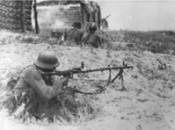
The Battle of Stalingrad began
July 17, 1942 began the Battle of Stalingrad (today Volgograd) - one of the major and fiercest battles, which radically changed the course of the Great Patriotic War and the Second World War. The Battle of Stalingrad is divided conventionally into two periods: the defensive (17 July - 18 November 1942) and the offensive (November 19, 1942 - February 2, 1943).
In the summer of 1942 the German troops launched an offensive on the southern flank of the Soviet-German front with in order to reach the fertile areas of the Don, Kuban, and the Lower Volga and oil regions of the Caucasus. For the attack on Stalingrad the second army under General F. Paulus that made part of the Army Group "B" was sent. By July 17, it included 13 divisions (about 270, 000 men, 3, 000 guns and mortars, and 500 tanks). They were supported by aircraft of the 4th Air Fleet (up to 1,200 combat aircrafts). Advancing enemy forces were opposed by Stalingrad Front, which was established by the Supreme Command July 12, 1942.
It consisted of the 62th, 63th, 64th, 21st, 28th, 38th, 57th armies and the 8th Air Army of the former South-Western Front. The Front was commanded by Marshal S. K. Timoshenko (from July 23 – by Lieutenant General V. N. Gordov). The task set for the Front was the following: to stop the further advance of the enemy holding the line on the area 520 km wide. Front started to fulfill the task having just 12 divisions (160, 000 men, 2, 200 guns and mortars, and 400 tanks), the 8th Air Force had 454 aircrafts. Besides, there were 150-200 long-range aircraft bombers and 60 fighters of the 102nd Air Division of the Air Defense. The enemy was superior of the Soviet forces in humans 1.7 times, in artillery and tanks 1.3 times, in airplanes more than 2 times.
From July 17, advance units of the 62nd and 64th Armies for 6 days fiercely resisted the enemy at the rivers Chir and Tsimla. The Germans were forced to turn a part of the main forces, and it allowed gaining time to improve the defense at the main line. As a result of heavy fighting the enemy's plans to encircle Soviet forces and break through to the city were thwarted.
In September 1942, for the capture of Stalingrad, the Germans established a group of 170, 000 men, primarily of the forces of the 6th Army. September 13, German troops reached the Volga near the gully Kuporosnaya; the next day, the enemy broke through to the center of the city, where fighting broke out for the train station "Stalingrad-I». According to the decision of the Supreme Command, the 13th Guards Rifle Division, commanded by Major General A. I. Rodimtsev was transferred here from the other bank of Volga. The crossing took place in difficult conditions under constant mortar and artillery fire. After landing on the right bank, the division immediately went into action for the town center, railway station, the 9th of January Square (now - Lenin Square) and Mamaev Kurgan.
October 14 Germans undertook the general assault of Stalingrad, which lasted three weeks: the attackers managed to get hold of the Stalingrad tractor factory and reach the Volga River in the northern sector of defense of the 62nd Army. November 14, the German command made a third attempt to take the city: after a desperate struggle the Germans took the southern part of the plant "Barricades" and broke through to the Volga. However, it was their last success.
The defensive period of the Battle of Stalingrad lasted almost three months. During this period, the Supreme High Command began to develop a plan, code-named "Uranus". In the area of operations on the Volga were sent representatives of the Headquarters - Army General G. K. Zhukov, Colonel-General A. M. Vasilevsky, Colonel-General of Artillery N. N. Voronov in order to study the issues related to the preparation of the counter-offensive. Stalingrad offensive operation ended February 2, 1943 with the defeat of Nazi forces.
October 15, 1967, in Volgograd, a monument-ensemble to “The Heroes of the Battle of Stalingrad" was inaugurated.
Lit.: Великая победа на Волге. М., 1965; Видер И. Катастрофа на Волге. Воспоминания офицера-разведчика 6-й армии Паулюса. М., 1965; То же [Электронный ресурс]. URL: http://militera.lib.ru/memo/german/wieder/index.html; Дёрр Г. Поход на Сталинград. М., 1957; То же [Электронный ресурс]. URL: http://militera.lib.ru/h/doerr_h/index.html; Исаев А. В. Сталинград. За Волгой для нас земли нет. М., 2008; То же [Электронный ресурс]. URL: http://militera.lib.ru/h/isaev_av8/index.html; Крылов Н. И. Сталинградский рубеж. М., 1979; Некрасов В. П. В окопах Сталинграда. М., 1995; То же [Электронный ресурс]. URL: http://militera.lib.ru/prose/russian/nekrasov1/index.html; Сталинград: К 60-летию сражения на Волге. М., 2002; Сталинградская эпопея: Сб. М., 1968.
Музей-заповедник Сталинградская битва: сайт. Б. д. URL: http://stalingrad-battle.ru.
Based on the Presidential Library’s materials:
The Battle of Stalingrad // Memory of the Great Victory: [digital collection];

